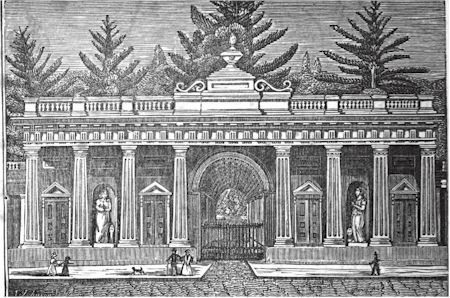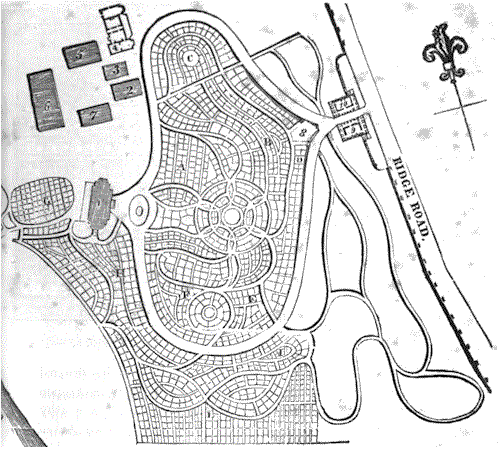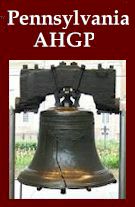Ground Plan of Laurel Hill Cemetery

Front View of Laurel Hill Cemetery
As far as the place was surveyed into separate tots, in 1837;
other surveys are progress. Purchasers may own one lot or more,
according to their inclination, the size of their families, and
receive a deed in perpetuity. The lots vary from __ feet by 10,
10 by 12, to 12 by 15, &c.

References. 1, Mansion; 2, Chapel; 3, Receiving Tomb; 4,
Superintendent Cottage; 5, Coach-house; 6, Stabling; 7,
Green-house; 8, Statues; 9, Garden Lodge; 10, Porter's Lodge;
11, Shrubbery; 13, River Schuylkill.
This "Home for the Dead," is beautifully situated on the Ridge
Road, about three miles from the City, and upon the banks of the
River Schuylkill. It was commenced by a worthy Association of
gentlemen, in 1836, who have procured an Act of Incorporation,
for the better furtherance of their purpose. The excellent
Secretary of the Hoard, says, one of the first objects of which
the Managers had in view, was to secure a spot, neither go near
the City, as to be in danger of encroachments, by new buildings
or streets, nor yet so far, as to present an obstacle, in the
time which must be employed, at a funeral pace, in reaching it.
Beauty of location, and a suitable soil, were also to be
consulted; with these views, it was a long time before a proper
place could be selected; all the requisites have been combined
in Laurel Hill, and among them, not the least in our view, is
the perfect adaptation of the Site, to its destined object, in
regard to scenery.
In the second place, it was determined to divest the Cemetery of
all objects, tending unnecessarily, to sadden the heart, or cast
a gloomy feeling over the mind. In the separation from near and
dear relatives and friends, we experience sufficient sorrow,
without the concomitants of a damp solitude, neglected tombs, or
walks.
The entrance is a pure specimen of Doric Architecture, perhaps
the only one in America. It occupies a space of two hundred and
sixteen feet, on the Ridge Road, three and an half miles from
Philadelphia; and the enclosed grounds embrace, something more
than twenty acres, extending from the turnpike to the river; the
greater part of the space being one hundred feet above the
highest watermark. The entrance presents a bold and commanding
appearance, through which, is a vista of great beauty. On each
side are lodges, for the accommodation of a gravedigger, and a
gardener, while within is a Cottage Ornee, in the English styles
for the residence of the Superintendent; a Gothic Chapel, of
beautiful proportions, and chaste workmanship, with a superb
(colored glass) window. A large Mansion House for visitors to
rest in, or to retreat to, in case of a storm; a handsome
receiving tomb, for those who may require its use; and stabling,
sufficient to accommodate 40 carriages, should it rain at the
time of a funeral; with a greenhouse, intended to be filled with
such ornamental plants and shrubs, as may be required, for the
embellishments of the grounds in summer, which, will not bear
the cold of winter.
In such a pleasing spot, where the birds sing over the graves,
and flowers and trees present their ever new verdure, the
dreariness is lost; the utter oblivion that awaits the tenant of
a confined graveyard, is forgotten death is here robbed of half
its horrors.
Every nation, at one period of its history, has thus
consecrated, a hallowed spot to the dead! Everywhere we trace
them in the characteristic remains of the most distant ages, far
back as history carries its traditionary outlines. They are
found in the cairns and mounds of olden times, reared by the
uninstructed affection of savage tribes, and everywhere the
spots seem to have been selected, with the same tender regard to
the living and the dead; that the magnificence of nature might
administer comfort to human sorrow, and excite human sympathy.
In these spots, family affection is gratified in the assurance,
that father and child may repose, side by side, and no
speculation scatter their bones, an offering to avarice, as has
frequently been done, in all our principal cities.
Extracts from the Regulations of the Cemetery
Persons on foot are admitted, on all days, except the Sabbath.
The carriages of lot holders have free access to the grounds.
Saddle horses, and dogs are not admitted. On the Lord's Day,
those only are admitted, who are in attendance on funerals. A
receiving tomb has been constructed, for the use of lot holders,
who are entitled to its use, for ten days in an inclement
season. In order to keep the walks in order, coachmen are
restricted to the avenues, and a broad wheeled carriage has been
erected, for the conveyance of building materials, used in
constructing tombs, vaults, monuments, enclosures, &c.
The raising the mounds, and erections of large slabs at the head
and feet of graves, are considered by the Managers, as in bad
taste, and injurious to the general appearance of the Cemetery;
they recommend the cultivation of flowers, over the hallowed
spots, or the construction of a flat monument of marble,
elevated a few inches only, above the surrounding surface. Lots
are not transferable, without the especial permission, in
writing, of the Managers.
This Cemetery was incorporated by the nature, at their session,
in 1836-7.
Since its establishment, Laurel Hill has received the patronage
of more than Five Hundred of our most respectable and wealthy
inhabitants, and we may state, without hesitation, that it is
already the pride of our noble City; it is visited by all
strangers, who cannot fail to bestow encomiums on the site; and
the manner in which everything is kept.
One Hundred Thousand Dollars have been expended upon this
elegant Cemetery.
History of Philadelphia

|
![]()

![]()
